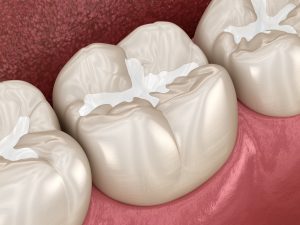What Are Dental Fillings?
Dental fillings repair teeth damaged by decay, cracks, or fractures. The procedure involves removing the damaged or decayed portion of the tooth and filling it with a tooth-colored resin material. Tooth fillings are a simple and effective solution to many dental problems and help you maintain good oral health.
Benefits of Dental Fillings

There are several benefits to getting dental fillings, including:
- Restoring Tooth Function: Fillings restore your tooth’s natural shape and function, allowing you to chew and speak properly.
- Preventing Further Damage: By filling in the damaged area, fillings ensure there’s no further damage to the tooth, such as decay or fractures.
- Enhancing Appearance: Tooth-colored fillings blend seamlessly with natural teeth for a more aesthetically pleasing appearance.
- Longevity: With proper care, dental fillings can last many years, providing a durable and long-lasting solution for your dental needs.
What Can Dental Fillings Fix?
Dental fillings can fix a wide range of dental problems, including:
- Cavities: Dental fillings treat cavities caused by decay. The filling restores the tooth’s shape and function, preventing further damage.
- Cracks and Fractures: Teeth cracked or fractured due to injury or trauma can be repaired with dental fillings.
- Worn Teeth: Over time, teeth can become worn down due to age, grinding, or other factors. Dental fillings can restore the tooth’s shape and prevent further wear.
- Discolored Teeth: Teeth that have become discolored due to injury or other factors can be repaired with dental fillings, restoring the tooth’s natural appearance.
The Dental Fillings Process
If you’re scheduled to receive a dental filling, it’s natural to wonder what the process will involve. Here’s what you can expect during the dental filling process:
- Numbing Affected Area: Before starting the filling process, Dr. Kovacevic will apply a local anesthetic to the gum tissue surrounding the affected tooth to ensure that you don’t feel any pain or discomfort during the procedure.
- Removing Damaged Tooth Structure: Once the anesthetic has taken effect, Dr. Kovacevic will begin removing all of the decayed or damaged tooth material.
- Preparing Tooth for Filling: After removing all the damaged tooth structures, your Greensburg dentist will clean the tooth to remove any remaining debris and bacteria and ensure the area is dry.
- Placing Filling: Your dentist will place the cosmetic filling material into the prepared tooth structure.
- Shaping and Polishing Filling: Once the filling material has been placed, Dr. Kovacevic will shape and polish it to ensure a comfortable fit and a natural appearance.
Dental Fillings Aftercare
Avoid Eating or Drinking Right After the Procedure
It’s best to wait for the anesthesia to wear off before eating or drinking anything. Eating or drinking immediately after the procedure can cause you to bite your tongue, lip, or cheek, which can lead to injury.
Practice Good Oral Hygiene
Brush your teeth twice daily and floss at least once daily to keep your teeth clean and healthy. Use a soft-bristled toothbrush and fluoride toothpaste to avoid damaging your filling.
Avoid Hard and Sticky Foods
Chewing on hard or sticky foods, such as hard candy or gum, can cause damage to your filling. Try to avoid these types of foods and opt for softer, healthier options like fruits and vegetables.
Schedule Regular Dental Checkups
Regular dental checkups are crucial for maintaining the health of your teeth and catching any potential issues early on. Be sure to schedule appointments with Dr. Kovacevic every six months for cleanings and checkups.
